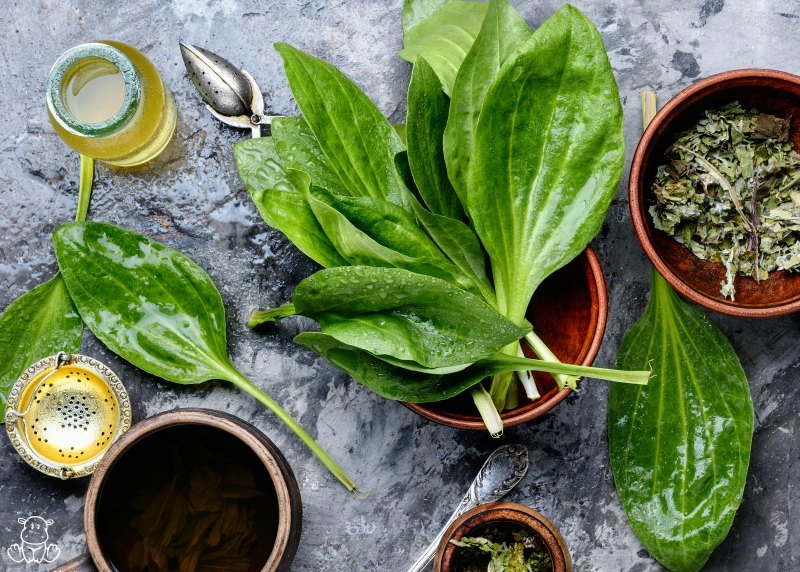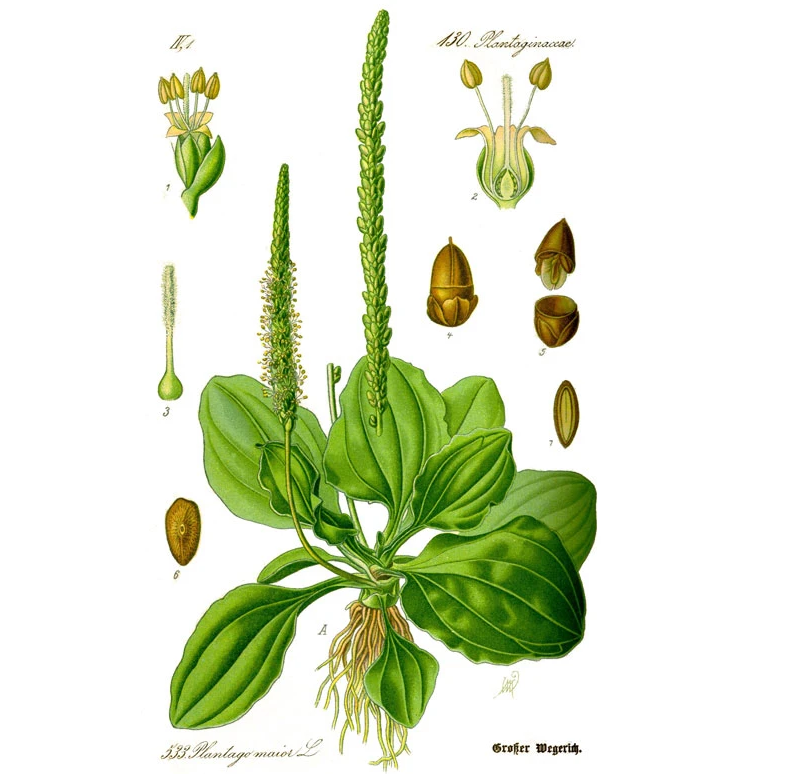SEPTEMBER – PLANTAIN

You might be surprised to see the name “Plantain” titling an article on local foraging.
Plantain jungles in New England? Well, sort of! But this is certainly not the Plantain you’ve met at the grocery store or your favorite taco joint. You have no doubt seen our local Plantain carpeting backyards, sidewalks, and footpaths all across our area. It’s the plant that everyone would recognize but likely can’t name. This humble weed is both prolific and incredibly useful, so if you haven’t met Plantain, it’s about time!

While there are hundreds of species of Plantain, the two best-known are “Broad-Leaf Plantain” (Plantago major) and “Narrow-Leaf Plantain” (Plantago lanceolata).
Plantain is best known and most easily recognizable by the tall and narrow flower stalk rising from the center of the basal florette of ribbed leaves on the ground.
As you get to know Plantain, you may hear the common name “White Man’s Footprint”, alluding to Plantain’s history as it followed the travels of European settlers around the world. This weed has long been an herbal remedy, celebrated by herbalists, utilized by indigenous peoples, and memorialized in folklore. It makes for the perfect weed to welcome to your ‘medicine cabinet’ and kitchen!
Plantain Poultice
A “poultice” is a preparation of moist, mashed herbs applied topically to support skin healing. Plantain makes one of the easiest and useful poultices there are! It’s super powers are soothing skin issues — reducing itches and pain from bug bite, staunching bleeding and preventing infection in minor abrasions. It’s also known to be a great remedy for drawing out splinters! So how to make a poultice? The fresh leaf works famously well as a “spit poultice”, made by chewing the fresh leaf and applying it to the affected area. While it’s not necessarily the most pandemic-friendly application, it sure works! Saliva converts certain compounds to be more effective, and you can easily cover your bit of mashed plantain with a bandaid or gauze, give your hands a good wash, and carry on with your day. Not into the spit poultice? You can totally go ahead and mash the leaf in your hands or with a mortar and pestle. I’ve personally seen the Plantain spit poultice work miracles for painful bee stings, stubborn splinters, and miserable mosquito bites. It makes for really simple and quite amazing foray herbalism for all ages!
Plantain “Egg” Replacement
For those who can’t eat eggs, you may have heard of flax eggs. Well move over imported Flax! With credit to @BlackForager (instagram), I recently learned that the mucilage containing seeds of Plantain makes a great vegan egg replacer for your baked goods.
- Find mature Plantain seed stalks where the seeds have started to loosen a bit from the stem.
- Snip them at the base of the stalk and give them a good rinse.
- Dry the entire stalk in a dehydrator on the lowest setting.
- Strip the dry seeds off the stem.
- Grind the seeds into a powder using a food processor or coffee bean grinder.
- Mix about 1 heaping TB of seed powder with about 2.5 TB water for about “one egg” worth of plantain, and let it sit for a few hours until it has a gel-like consistency.
- Use that “gel” as you would an egg in your favorite baked goods!
As always, be sure to forage from a place that you know is free of harmful chemicals, exhaust from vehicles, or animal refuse. You don’t have to worry about over-harvesting Plantain since it’s so abundant. Get to know this lovely plant and introduce Plantain to your friends! Getting to know your plant neighbors cultivates connection to place. It reminds us that we are interconnected with the birds and the bees, the weeds and the trees. Hopefully by learning how to utilize the abundant plants in our region you will love where you live more than ever!
Happy September & happy foraging, friends!

Carissa Wills-Demello
Author
Carissa is Westport native, a practicing herbalist, a lover of wild plants, and owner of Bilo Herbs. You can enjoy Dandelion and other nutritious weeds in her herbal tea blends, syrups, and vinegars! (Check out www.BiloHerbs.com)

